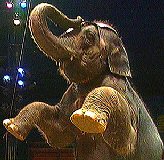
The Issues
Captive Animals Used In Entertainment
 Circuses
Circuses
Animals don't want to ride bicycles, stand on their heads, balance on balls, or jump through rings of fire. Sadly, they have no choice. Circus trainers use abusive tools, like whips and electric prods, and force them to perform. Not only are elephants, bears, tigers, and other animals abused by trainers, they suffer from extreme loneliness, boredom, and frustration from being locked in tiny cages or chains month after month, city after city. Instead of being treated like furniture, constantly being loaded and unloaded into trucks and storage areas, these animals should be in their natural habitat, exploring, seeking mates, and raising families.
Zoos
Zoo animals similarly suffer hugely as a consequence of their captivity. Many zoos operate under a false pretence of “conservation”; they claim that keeping the animals is helping their numbers in the wild. This is far from the truth. Many zoo animals have been taken from the wild in the first place but rather than get released back into the wild after breeding programmes they remain in captivity until the day they die. In all zoos stereotypic/repetitive behaviour is commonplace (ie: behavioural disturbances, including pacing, head-bobbing, rocking, swaying, bar-biting, pulling out hair and feathers, and self-inflicted wounds). Animals are often kept in unsuitable habitats in enclosures that are too small or poorly designed.
Aquariums
Aquariums are another example of cruel exploitation and are the cause of worries about the diminishing numbers of fish in coral reefs. Most public aquaria only exist because of the trade in animals removed from the wild. In some cases welfare problems in aquaria are so great that many animals die soon after being put on display, to be soon replaced by yet more wild-caught individuals.
Further information:
The Captive Animals' Protection Society (CAPS)
http://www.captiveanimals.org/
The Born Free Foundation